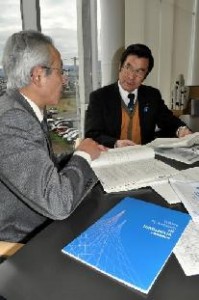Fukushima and Hiroshima: Reconstruction and Reality, Part 7 [5]
Dec. 15, 2011
Article 5: Damage “beyond the scope of assumptions”
by Yo Kono, Staff Writer
Bold legislative measures are urgently needed
In the wake of the accident at the Fukushima No. 1 (Daiichi) nuclear power plant, triggered by the Great Eastern Japan Earthquake, the magnitude of the damage to the affected areas has been described as “beyond the scope of assumptions.” The fact that this damage is greater than what had been conceived prior to the accident is proving a hindrance to reconstruction efforts.
One factor hampering the reconstruction work involves legislation. As one example, the Waste Management Law contains no stipulation on how debris contaminated by radioactive substances should be disposed of. To this point, only about 37 percent of the debris, of a total of 4.38 million tons collected within the boundaries of Fukushima Prefecture, has been delivered to temporary storage sites. The full-blown effort to dispose of this waste will be launched in January 2012 when a special law will take effect which concerns environmental contamination as a consequence of radioactive materials.
Two-year limit for living in temporary housing
Another example is temporary housing. Today, about 30,000 people are living in temporary housing in Fukushima Prefecture. According to the current disaster relief law, people are permitted to reside in temporary housing up to two years. But if such limits hold, those like Machiko Kikuchi, 60, who is originally from the town of Okuma and now lives in temporary housing in the city of Aizuwakamatsu, will have nowhere to go once the two-year time period has passed.
“The Japanese Diet is supposed to make and amend the laws,” Ms. Kikuchi said. “Why can’t it respond more quickly to the needs of the people affected by this disaster?” In these days of uncertainty, Ms. Kikuchi’s frustration has grown daily as she watches the rival parties of legislators continue their political skirmishing.
In addition, the costs involved in the reconstruction work are staggering. On December 1, the Fukushima prefectural government formulated its first draft of the Fukushima Prefecture Reconstruction Plan. The plan is comprised of 710 projects, but the amount of money needed to realize their success remains unknown. An official of the prefectural government admitted: “I have no idea how much it will cost.”
At the same time, unemployment has become a serious concern. The number of newly unemployed in Fukushima Prefecture reached as many as 46,000 in the wake of the earthquake. Among the 17 companies located in the Naraha Minami Industrial Complex in the town of Naraha, about 20 kilometers from the crippled nuclear plant, only two have been able to resume operations. The city of Aizuwakamatsu, which once welcomed about 3.5 million tourists a year, has seen a steep drop of about 90 percent in the number of students on school trips from outside Fukushima Prefecture since the earthquake and nuclear accident. Implementing financial measures to support those affected, such as offering compensation and tax credits, is a vital step.
Bearing Hiroshima in mind
“The situation in Fukushima demands that laws be developed in a bold fashion, without getting mired in examples of the past,” stressed Yoshiaki Ando, 59, a member of the Date City Council.
He points to the Hiroshima Peace Memorial City Construction Law, which was enacted four years after the end of the war. It was the first law in Japan passed expressly for the benefit of a local municipality. The City of Hiroshima was provided a special budget and special authority by the central government. The law also enabled the city to obtain additional subsidies as well as state-owned properties. Hiroshima Peace Memorial Park and Peace Boulevard were developed in accordance with this law.
At a meeting of the Reconstruction Plan Exploratory Committee held at Fukushima Prefectural Hall on November 14, one committee member said, “We’re facing problems that must be given priority over constructing facilities that may not be needed in 20 years.” This comment was made from the recognition that the reconstruction efforts led by the central government are sometimes at odds with the needs of the local residents. After hearing this remark, Takanori Seto, mayor of Fukushima City, raised his voice to say, “Local municipalities must be assertive in our dealings with the central government.” Mr. Seto also serves as the president of the Fukushima Mayors Association.
The revival of Fukushima Prefecture is being watched by the world. It is essential that a system be established in which the local communities themselves can draw their own road map to reconstruction without being weighed down by conventional methods. This effort must be swift and bold and uphold the lives of the local residents as the highest priority.
(Originally published on December 10, 2011)








